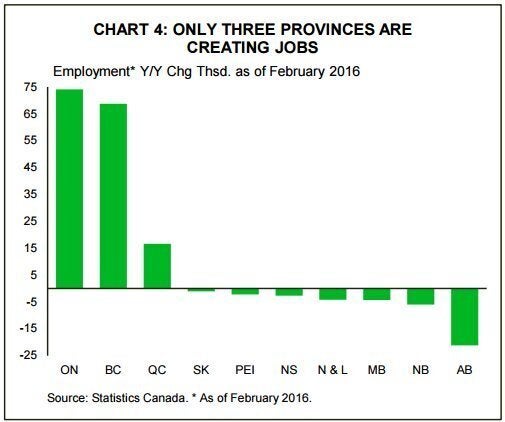
As Canada's economy shifts to adjust to low oil prices and a lower loonie, job growth has become concentrated in just three provinces, TD Bank noted Tuesday.
Canada’s economy is diverging more than expected in the wake of the oil price crash, with energy provinces doing worse than forecast while non-energy provinces grow more strongly than predicted, the bank's latest provincial economic forecast said.
That's good news for Ontario, B.C. and other non-energy-producing provinces. TD Bank sees these regions growing between 2.4 and 3 per cent — growth rates rarely seen since the financial crisis of 2008.
Meanwhile, the oil-producing provinces will continue to underperform the rest of the country, the report said.
This year and last “will mark the sharpest two-year economic underperformance of oil-dependent economies relative to the rest of Canada since the oil crash of the 1980s,” TD economists wrote in their report.
With weakness in the oil provinces and sluggish growth in Atlantic Canada, that leaves just three provinces that created jobs over the past year, TD noted: British Columbia, Ontario and Quebec.

Ontario added 74,000 jobs in the 12 months running up to February of this year, while much smaller British Columbia added nearly as many — 68,000 jobs, a solid 3-per-cent jump in a year. Quebec added 16,600 jobs in that time.
This concentration of jobs particularly in Ontario and B.C. could partly explain the massive growth in home sales and prices in Toronto and Vancouver over the past few years.
TD Bank says the ugly job situation in the oil provinces will be improved by the fact that energy industry workers are mobile, and are already moving to places with jobs, primarily B.C.
That will help keep the unemployment rate in oil provinces from spiking too high, but it will also mean jobless rates in other provinces won’t fall much further, as they will see an influx of people looking for work.
TD Bank expects Ontario’s unemployment rate to hover around 6.9 per cent over the next two years, largely unchanged from last year.
British Columbia’s unemployment rate will rise to 6.8 per cent, from an annualized rate of 6.2 per cent last year, as more Albertans show up looking for work.
It sees Alberta’s unemployment rate rising to 8.2 per cent this year, before dropping somewhat to 7.8 per cent in 2017.

Also on HuffPost:
